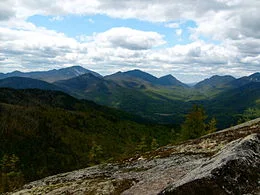The Adirondack Mountains are a crystalline massif that runs through the state of New York (44° 7' N; 73° 55' W); in particular, they are part of Clinton, Essex, Franklin, Hamilton, Herkimer, Lewis, and Warren counties. Located in an extension of the Appalachian Mountains, they geologically belong to the Laurentian Mountains of Canada. It is bordered to the east by Lake Champlain and Lake George, which separate it from the Green Mountains (Vermont). The southern boundary is the Mohawk River Valley. Beyond the Mohawk, to the west, is the Tug Hill Plateau, and to the north is the St. Lawrence River. The Adirondacks represent one-fifth of the New York State area and number 4,000 streams. They consist mainly of metamorphic rocks, especially gneiss.
 |
| Adirondack Mountains New York |
The Adirondack Mountains do not form a united mountain chain, but instead consist of many peaks, both isolated and grouped together. There are more than a hundred different peaks, between 1,200 and 5,000 feet (370m to 1,500m) in altitude; the highest peak is Mount Marcy (1629m) (formerly called Tahawus), in the eastern part of the range. The Adirondack Mountains also have 46 peaks near 4,000 feet (1,219m). The main mountains are; "i 46" were climbed between 1918 and 1924 by brothers Robert and George Marshall. The Adirondack Mountains are part of the 6.1 million acre (25,000km2) Adirondack Park, which contains the Forest Preserve.
 |
| Adirondack Mountains New York |
About 43% of the land is owned by the State, while 57% is owned by private citizens, under strict regulation by the Adirondack Park Agency. The park contains thousands of streams and lakes, including Lake Placid, adjacent to the town of Lake Placid, born to have hosted the 1932 and 1980 Winter Olympics, Lake Saranac, and Lake Raquette. The park is a major destination for canoe and kayak enthusiasts.
The North Woods Canoe Trail begins in the Adirondacks at Old Forge and travels 147 miles across the Raquette River, Forked Lake, Long Lake, Saranac Lake, Flower Lake, then across the Saranac River to Lake Champlain, before continuing on to Maine, crossing Vermont, Quebec and New Hampshire. In this place is the source of the Hudson River that crosses and empties into the city of New York.